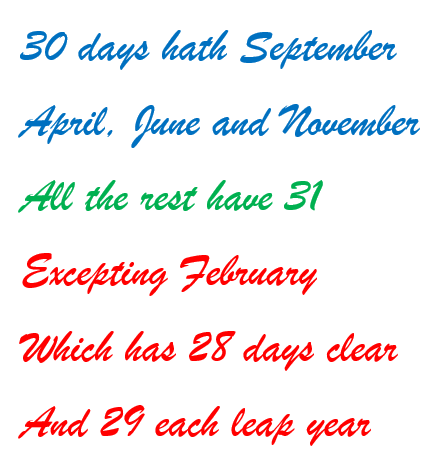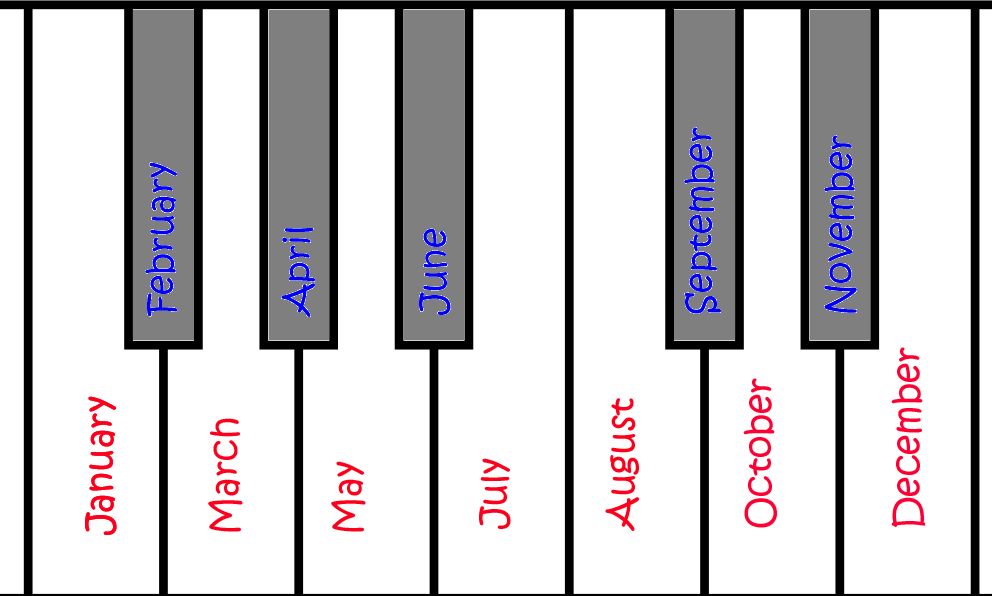Prekinder to Grade 2 Mathematics
Months
Months

This is Blublubox, a friendly alien from the planet BleBeep who is visiting the Earth. He'd like to find out about how Earthlings measure time. Today he's interested in finding out what a month is. Let's see if we can help him.
What is a Month?
A month is one of \(12\) time periods that a year is divided up into. Each month has a different name. Here is a list of the months of the year, and the abbreviations we sometimes use for them.
| Month | Abbreviation |
|---|---|
| January | Jan |
| February | Feb |
| March | Mar |
| April | Apr |
| May | May |
| June | Jun |
| July | Jul |
| August | Aug |
| September | Sep |
| October | Oct |
| November | Nov |
| December | Dec |
On Earth, we use calendars to show all the months of the year. The order of the months given above is the same as the order in calendars. January is the first month of the year, and December is the last month of the year.
If you look at the calendar below, you'll notice that the months have different lengths:

See how some months have \(30\) days and some have \(31\) days? February is the shortest month of all, with only \(28\) days on this calendar. February is even stranger than that! In some years (called leap years),
February has \(29\) days.
At one time, we used the moon to give us the length of the months. The moon takes about \(28\) days to orbit the Earth once. This would give us a year with \(13\) and a bit months in it, so it isn't really practical.
However, our word for month comes from "moonth", and we still use \(28\) days as an estimate for the length of a month. In fact, we call \(28\) days a lunar month after the moon. Eventually,
the lengths of the months were adjusted to give us a year made up of \(12\) months.
Remembering the lengths of the months
Of course, with all these months having different lengths, it can be difficult to remember which months have \(31\) days and which months have \(30\) days. It is easy to remember that February has \(28\) days (most of the time), but the rest need some work. School children are taught a couple of different ways to remember how many days each month has.
The first one is this poem:

Another method that is commonly taught is to use the knuckles on your hands. This won't work so well for you, Blublubox, but humans can use their knuckles to find the short months. First, they line up their fists so that their thumbs are hidden, and the tops of their hands face upwards. Starting with their left hand, they count up the months on their knuckles and the grooves between them. January starts on the knuckle of the pinky finger, February falls in the groove, March is on the second knuckle, April in the groove, and so on. The short months are the ones that land in the grooves and the long months are the ones on the knuckles. Of course, you have to remember that February has \(28\) or \(29\) days to use this technique.
Here's a method for people who can play the piano, or who know a bit about music. You can count up the months on the piano keys like this:

You start with January on an F, then label each (black and white) key with the names of the months in order. The months that land on the black keys are the short months. The months that land on the white keys all have \(31\) days. This is basically the same as the knuckle method, with the knuckles replaced by the white keys and the grooves between the knuckles replaced by the black keys.
An Aside on the History of the Names of the Months
The Ancient Romans came up with the names for the months. Some were named after Roman gods, two were named after Roman emperors, and the rest were named after numbers. The original Roman calendar only had \(10\) months (no January or February). Numa Pompilius added January and February in 710 BC. This meant that the month names that came from numbers were now out by two. In 44 BC, two of the months were renamed in memory of Julius and Augustus Caesar (can you guess which ones?).
Here are the names of the months and their Ancient Roman Origins:
| Month | Origin |
|---|---|
| January | Named after the Roman god, Janus, of beginnings and endings. |
| February | Named after the old Italian god, Februus. |
| March | Named after the Roman god, Mars, of war. |
| April | This was the first month of spring. It may have been named Aprilis, from the Latin 'aperire', meaning 'to open'. Buds on trees and flowers open in spring. |
| May | Named after the Roman goddess, Maiesta. |
| June | Named after the Roman god, Juno. |
| July | Named after emperor Julius Caesar. |
| August | Named after emperor Augustus Caesar. |
| September | This comes from the Latin, 'septem', meaning 'seven'. |
| October | This comes from the Latin, 'octo', meaning 'eight'. |
| November | This comes from the Latin, 'novem', meaning 'nine'. |
| December | This comes from the Latin, 'decem', meaning 'ten'. |
Conclusion
So, Blublubox, that's all I can tell you about the time period called a month. If you want to find out more about time units on Earth, you can read the articles on days, weeks and years. There are also some articles on telling the time that might interest you.
Description
This mini book covers the core of Math for Foundation, Grade 1 and Grade 2 mathematics including
- Numbers
- Addition
- Subtraction
- Division
- Algebra
- Geometry
- Data
- Estimation
- Probability/Chance
- Measurement
- Time
- Money
- and much more
This material is provided free of cost for Parent looking for some tricks for their Prekinder, Kinder, Prep, Year 1 and Year 2 children
Audience
Grade 1/Year 1, Grade 2/Year 2, Prep, Foundation, Kinder and Pre-Kinder
Learning Objectives
These lessons are for kids aged 4-8 with the core objective to expose their brains to concepts of addition, subtraction, division, algebra and much more.
Author: Subject Coach
Added on: 6th Apr 2018
You must be logged in as Student to ask a Question.
None just yet!